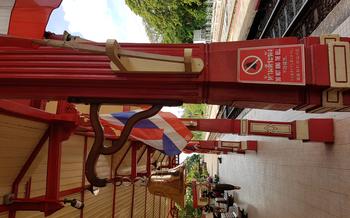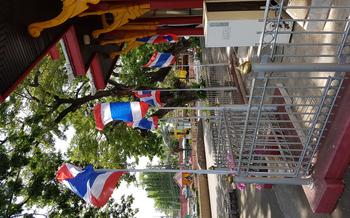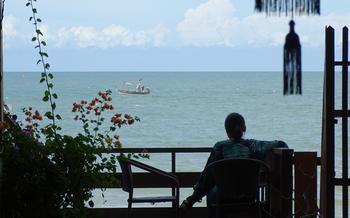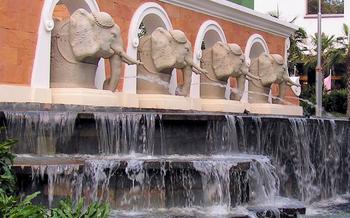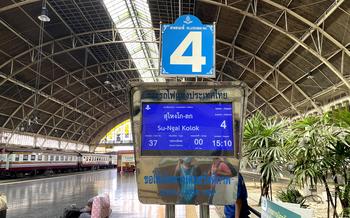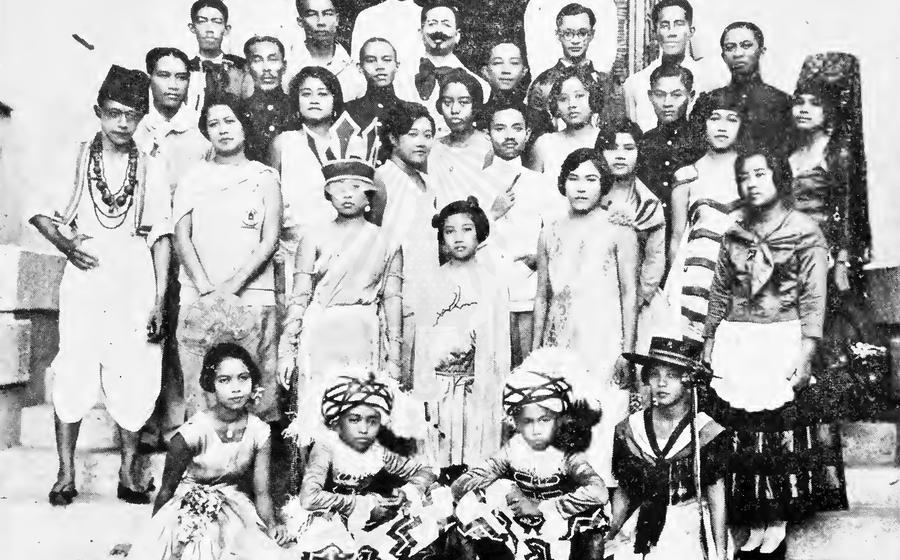
Klai Kangwon Palace
- Historical Significance
- Architectural Beauty
- Landscaped Gardens
- Throne Hall and Reception Areas
- Royal Accommodations
- Public Access and Tours
- Exhibitions and Displays
- Ceremonial Significance
- Symbolic Importance
- Nearby Attractions
- Getting There
- From Bangkok:
- From Other Cities:
- Map and Directions:
- Dress Code and Etiquette
- Insider Tip
Historical Significance
Klai Kangwon Palace, nestled amidst the serene landscapes of Hua Hin, holds a significant place in the history of the Thai monarchy. Constructed in 1926 by King Prajadhipok (Rama VII), the palace served as a summer residence for the royal family, offering respite from the bustling city life of Bangkok. Its name, translating to "Far from Worries," reflects the monarch's desire for a tranquil retreat away from the pressures of kingship.
Over the years, Klai Kangwon Palace has witnessed numerous historical events and played host to distinguished guests. King Bhumibol Adulyadej (Rama IX), Thailand's longest-reigning monarch, spent many summers at the palace, using it as a retreat for relaxation and contemplation. The palace also hosted several official ceremonies and royal receptions, welcoming dignitaries and foreign officials from around the world.
One of the most notable events associated with Klai Kangwon Palace was the signing of the Thai-Japanese Friendship Treaty in 194This treaty, signed during World War II, marked a significant moment in Thailand's history and was instrumental in shaping the country's foreign policy during the conflict.
The palace remains a cherished symbol of the Thai monarchy, representing its rich history, traditions, and cultural heritage. Its enduring legacy attracts visitors from around the world, eager to explore its opulent halls and immerse themselves in the grandeur of Thailand's royal past.
Architectural Beauty
Klai Kangwon Palace stands as a testament to the harmonious blend of traditional Thai and Western architectural styles. The palace's teakwood structures, meticulously crafted by skilled artisans, exude an aura of elegance and grandeur. Intricate carvings adorn the eaves, doors, and windows, showcasing the artistry and attention to detail that went into its construction. The vibrant colors that embellish the palace's exterior reflect the rich cultural heritage of Thailand, adding a touch of vibrancy and cheer to the serene surroundings.
The palace's design incorporates elements of both Thai and European architecture, resulting in a unique and eclectic style. The main residence, known as the Wang Klai Kangwon, showcases a traditional Thai architectural style with its gabled roofs, intricate woodwork, and brightly painted facades. In contrast, the Phra Tamnak Piamsuk Montra Pavilion, built during the reign of King Rama VI, exhibits a more European influence with its classical columns, arched windows, and ornate decorations.
The harmonious fusion of these architectural styles creates a visually captivating ensemble that reflects the eclectic tastes and influences of the Thai royal family. Klai Kangwon Palace stands as a testament to the enduring legacy of Thai craftsmanship and the enduring appeal of blending traditional and modern elements in architectural design.
Landscaped Gardens
The sprawling gardens surrounding Klai Kangwon Palace are a testament to the artistry and vision of renowned landscape architects. Designed to create a harmonious blend of natural beauty and royal grandeur, these gardens offer visitors a tranquil oasis amidst the bustling city.
The gardens burst with color and fragrance, featuring a diverse array of flowers, plants, and trees. Visitors can admire the delicate petals of orchids, the vibrant hues of hibiscus, and the exotic blooms of frangipani trees. Lush green lawns provide a contrast to the vibrant flora, creating a serene and inviting atmosphere.
The gardens are meticulously manicured, with winding paths that lead visitors through a labyrinth of beauty. Visitors can stroll along the paths, enjoying the shade of towering trees and the gentle rustling of leaves. The gardens also feature tranquil ponds, adorned with water lilies and lotus flowers, adding an element of serenity to the landscape.
The significance of the gardens lies in their ability to provide a serene and relaxing atmosphere for the royal family. The gardens offer a sanctuary where the royals can escape the rigors of their official duties and reconnect with nature. The tranquil surroundings and the beauty of the gardens create an environment conducive to relaxation and contemplation.
Throne Hall and Reception Areas
The throne hall of Klai Kangwon Palace exudes an aura of grandeur and opulence, serving as the venue for official ceremonies, royal audiences, and state functions. This magnificent hall is adorned with intricate decorations, featuring gilded moldings, shimmering chandeliers, and vibrant murals depicting scenes from Thai history and mythology. The centerpiece of the throne hall is the elevated platform where the Thai monarch presides over ceremonies, flanked by ornate thrones and royal regalia.
Adjacent to the throne hall are the reception areas, where guests and dignitaries are received by the royal family. These elegant spaces are furnished with plush sofas, antique tables, and exquisite artwork, creating a refined and welcoming atmosphere. The reception areas also feature balconies and verandas that offer stunning views of the surrounding gardens and the Gulf of Thailand beyond.
During royal receptions and events, the throne hall and reception areas come alive with the presence of the Thai royal family, foreign dignitaries, and distinguished guests. Strict protocols and customs are observed, reflecting the deep respect and reverence accorded to the monarchy. Visitors are granted a glimpse into the grandeur and formality of Thai royal ceremonies, gaining a deeper understanding of the rich cultural heritage of the kingdom.
Royal Accommodations
Within the majestic walls of Klai Kangwon Palace, the private living quarters of the Thai royal family offer a glimpse into their refined taste and regal lifestyle. These exclusive residences are designed with meticulous attention to detail, blending modern amenities with traditional Thai elements. Each room boasts luxurious furnishings, intricate artwork, and personal touches that reflect the individual preferences of the royal occupants.
The master bedroom, reserved for the reigning monarch, exudes an aura of grandeur with its opulent décor and sweeping views of the palace gardens. The bed, adorned with intricate carvings and plush bedding, is fit for royalty. Adjoining the bedroom is a private sitting room, a sanctuary for relaxation and contemplation, adorned with elegant furnishings and a collection of prized possessions.
Other royal residences within the palace offer a similar level of comfort and luxury. Each family member's private quarters are tailored to their unique needs and interests, reflecting their personal style and passions. From spacious living areas to private dining rooms, every detail is meticulously considered to ensure the utmost comfort and privacy for the royal family.
These royal accommodations serve as a sanctuary for the Thai royal family, providing a private retreat from their public duties. The palace's serene atmosphere, coupled with the luxurious amenities and personal touches, creates a welcoming and comfortable environment for the royal family to relax, unwind, and spend quality time together.
Public Access and Tours
Klai Kangwon Palace is not just a royal residence; it also welcomes visitors who wish to explore its grandeur and historical significance. Guided tours are available for the public, offering an insightful journey into the palace's history, architecture, and royal traditions. These tours are conducted by knowledgeable guides who share fascinating stories and anecdotes about the palace and its inhabitants. Visitors are taken through the various halls, gardens, and reception areas, providing a glimpse into the lives and customs of the Thai monarchy.
When visiting the palace, it is important to be aware of certain restrictions and protocols. Visitors are required to dress appropriately, avoiding shorts, tank tops, or revealing clothing. Photography and videography are permitted in most areas, but there may be specific restrictions in certain sections or during special events. It is important to be respectful of the privacy of the royal family and other visitors while capturing memories of the palace.
Opening the palace to the public is a testament to the Thai monarchy's commitment to cultural appreciation and understanding. By allowing visitors to explore the palace grounds, the royal family shares a piece of their history and heritage with the world, promoting cultural exchange and fostering a deeper appreciation for Thai traditions and customs.
Exhibitions and Displays
Klai Kangwon Palace houses several exhibitions and displays that offer visitors a glimpse into the rich history, culture, and traditions of the Thai monarchy. These exhibitions showcase a diverse collection of artifacts, royal portraits, historical documents, and personal belongings that provide insights into the lives and reigns of past Thai kings and queens.
One of the highlights of the palace's exhibitions is the display of royal regalia, including elaborate crowns, scepters, and ceremonial robes. These exquisite artifacts symbolize the power and authority of the Thai monarchy and are a testament to the craftsmanship and artistry of Thai artisans. Visitors can also admire a collection of royal portraits that depict various Thai monarchs throughout history, each capturing their unique personalities and contributions to the kingdom.
In addition, the palace showcases historical documents and photographs that chronicle the development of the Thai monarchy and its role in shaping the nation's history. These documents provide valuable insights into the political, social, and cultural transformations that Thailand has undergone over the centuries.
The exhibitions at Klai Kangwon Palace not only serve as a window into the past but also contribute to the preservation and promotion of Thai cultural heritage. Visitors can gain a deeper understanding of the monarchy's significance and its enduring impact on Thai society and identity.
Ceremonial Significance
Klai Kangwon Palace serves as a grand stage for various official ceremonies and royal events that uphold Thai royal customs and traditions. One of the most notable ceremonies held within the palace is the annual Royal Ploughing Ceremony. This ancient ritual, dating back to the Sukhothai Kingdom, symbolizes the commencement of the rice-growing season and pays homage to the agricultural roots of the Thai people. During the ceremony, the King, dressed in traditional attire, plows a ceremonial furrow in the palace grounds, invoking blessings for a bountiful harvest and prosperity for the nation.
Other significant events hosted at Klai Kangwon Palace include royal birthdays, state banquets, and official receptions for foreign dignitaries. These grand occasions showcase the splendor and opulence of the Thai monarchy, with elaborate decorations, traditional music and dance performances, and the presence of distinguished guests from around the world. The palace's ceremonial significance reinforces its role as a symbol of national unity, cultural heritage, and the enduring traditions of the Thai people.
Symbolic Importance
Klai Kangwon Palace stands as a potent symbol of the Thai monarchy, embodying the nation's rich history, cultural heritage, and deep-rooted traditions. Its majestic architecture, sprawling gardens, and opulent interiors reflect the grandeur and prestige of the Thai royal family. Beyond its physical presence, the palace holds immense symbolic value as a representation of the monarchy's enduring legacy and its central role in Thai society.
Preserving and maintaining Klai Kangwon Palace is of paramount importance in safeguarding Thailand's national identity and heritage. The palace serves as a tangible link to the past, showcasing the architectural achievements, artistic traditions, and cultural practices that have shaped the nation over centuries. By honoring and protecting this architectural marvel, Thailand pays homage to its proud history and ensures that future generations can appreciate the legacy of their ancestors.
Nearby Attractions
Hua Hin offers a wealth of attractions beyond Klai Kangwon Palace, promising a diverse and fulfilling travel experience. Just a short distance away, visitors can immerse themselves in the vibrant atmosphere of the Hua Hin Night Market, a bustling bazaar known for its delectable street food, souvenirs, and local crafts. For a refreshing seaside escape, Hua Hin Beach beckons with its pristine sands and inviting waters, offering فرص opportunities for swimming, sunbathing, and water sports.
History buffs can delve into the region's rich past at the Mrigadayavan Palace, a former royal residence transformed into a museum showcasing fascinating exhibits on the history and culture of Hua Hin. Nature enthusiasts will find solace in the serene landscapes of the Khao Takiab Monkey Mountain, home to a playful troop of monkeys and offering breathtaking panoramic views of the surroundings.
For a spiritual retreat, Wat Huay Mongkol, adorned with a majestic Buddha statue, offers a tranquil atmosphere for reflection and meditation. Art aficionados can appreciate the creative expressions at the Hua Hin Artists Village, where local artists showcase their unique talents through paintings, sculptures, and handmade crafts. These nearby attractions complement a visit to Klai Kangwon Palace, creating a comprehensive and memorable travel experience in Hua Hin.
Getting There
Reaching Klai Kangwon Palace is a convenient and straightforward experience, offering visitors multiple transportation options from Bangkok and other major cities in Thailand.
From Bangkok:
-
By Bus: Regular buses depart from Bangkok's Southern Bus Terminal, offering a comfortable and affordable journey to Hua Hin. The trip takes approximately 3-4 hours, and buses arrive at the Hua Hin Bus Station. From there, visitors can take a taxi or tuk-tuk to the palace.
-
By Train: The State Railway of Thailand operates trains from Bangkok's Hua Lamphong Railway Station to Hua Hin. The train ride offers scenic views along the way and takes about 4-5 hours. Upon arrival at Hua Hin Railway Station, visitors can take a taxi or tuk-tuk to the palace.
From Other Cities:
-
By Bus: Direct buses to Hua Hin are available from various cities across Thailand, including Chiang Mai, Phuket, and Surat Thani. The journey time varies depending on the distance, but most buses arrive at the Hua Hin Bus Station. From there, visitors can take a taxi or tuk-tuk to the palace.
-
By Train: Train services connect Hua Hin with major cities like Nakhon Pathom, Ratchaburi, and Prachuap Khiri Khan. Visitors can board trains from respective railway stations and alight at Hua Hin Railway Station. From there, taxis or tuk-tuks can be taken to the palace.
Map and Directions:
To assist visitors in navigating to Klai Kangwon Palace, a detailed map or directions can be easily obtained online or through local tourist information centers. The palace is situated approximately 10 kilometers south of Hua Hin town center. Visitors can follow clear road signs or use GPS navigation to reach the palace grounds.
Dress Code and Etiquette
When visiting Klai Kangwon Palace, it is essential to dress appropriately to show respect for Thai cultural norms and royal protocols. Visitors should avoid wearing shorts, tank tops, or revealing clothing. Instead, opt for modest and conservative attire. For men, long pants and a collared shirt are suitable, while women can wear long skirts or dresses that cover the shoulders.
It's important to maintain respectful behavior while exploring the palace grounds. Avoid loud noises, refrain from touching or leaning on exhibits, and be mindful of your surroundings. Photography and videography are generally allowed, but visitors should be discreet and avoid taking photos or videos of the royal family or other visitors without their consent.
By adhering to the dress code and following proper etiquette, visitors can demonstrate their respect for Thai culture and contribute to preserving the dignity of Klai Kangwon Palace as a royal residence.
Insider Tip
For a unique perspective of Klai Kangwon Palace, head to the secluded Royal Beach, nestled along the coastline within the palace grounds. This private stretch of sand is accessible via a picturesque path leading from the palace gardens. Visitors can bask in the sun, stroll along the shore, or take a refreshing dip in the tranquil waters, enjoying a serene escape from the bustling tourist areas. Pack a picnic lunch and make a day of it, soaking up the natural beauty and tranquility of this hidden gem.
